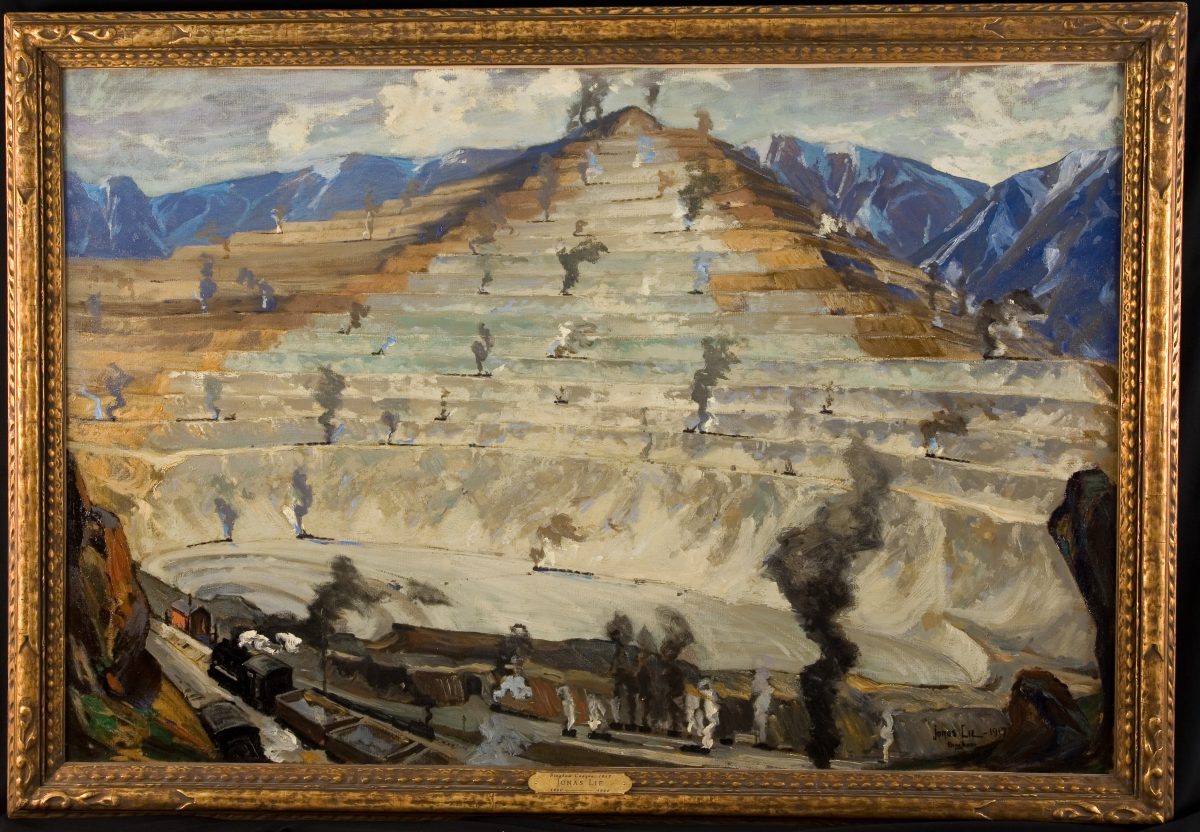By Jessica Breiman, Special Collections Digital Archives Librarian, University of Utah J. Willard Marriott Library
The digital exhibition Mining the West: Primary Elements began as a loose collaborative experiment in uniting objects of interrelated content from J. Willard Marriott Library Special Collections and the Utah Museum of Fine Arts (UMFA) at the University of Utah. The experiment quickly turned into a deep reflection of archival materials and visual art, and how they jointly illuminate new facets of historical topics. Using objects from both collections, the exhibition illustrates the technological, economic, social, and environmental impacts of mining on the American West. Contributions from artists, scientists, educators, and more demonstrate a diversity of perspectives on this topic.
This experiment originated as part of the Landscape, Land Art, and the American West initiative between the UMFA and the Marriott Library, funded in part by the Andrew W. Mellon Foundation. This initiative aimed to deepen collaboration between the institutions and draw connections between their respective collections.
The use of visual art in historical explorations calls for creativity and deep engagement with the objects. Historians must expand their concept of rhetoric as they interrogate materials that are deliberately open to interpretation. This practice often adds a layer of humanity to historical research, as researchers delve into questions beyond textual analysis and consider how, and why, artists interpreted their worlds. What ideas are communicated by choice of subject matter and medium, arrangement and composition, color palette, style, perspective, and line of sight?
Take, for instance, these two photos by Lewis W. Hine, placed adjacent to each other in a scrapbook in the UMFA’s collection.

Researchers examining Steel Mill Workers of Today and A Miner of the Old School (both ca. 1918) might start with an initial assessment of the work by observing the subjects of the work; the differences between the men in respect to their clothing, their hats, their age, and what they carry with them to work, whether tools or lunch pails. Many of the juxtapositions in this work—the group portrait versus the individual portrait, the arrangement of images into upper and lower halves, the bare background in the solo portrait in contrast to the buildings and occupied areas of the group portrait—suggest to me questions about the individual experiences of contemporary and past laborers, the future of employment, and the experience of labor as a communal or solitary endeavor. As technology and industry demands changed, what would have it been like to be one of the solitary, likely aging, “old school”? The subjects face the camera, creating a direct interaction with the viewer. Could that artistic choice message a challenge to viewers to engage with those who labored in mines or steel mills? How does this object suggest more lenses of examination for the study of labor in this era? How might our reading of these photos shift when examining them in tandem with archival material from the same exhibition, for instance, the Union Coal Miners of Utah 1923 Utah Statement and Brief Concerning the Campaign of the Coal Operators of Utah Against Organized Labor and the Unionizing of the Utah Coal Fields?

As researchers return to archival objects, they may see them in a different light and find new angles of meaning. For instance, what does the visual arrangement of articles or photographs in an anonymous scrapbook communicate about the creator? What can the graphics on stock certificates—eagles or cowboys, abstract or pictorial, fanciful or geometric—communicate about the company that issued them? Alternatively, these objects may spur researchers to expand their original research questions as they consider whether the work of art contradicts or enhances archival sources, or simply adds another voice to the historical conversation. Visual art challenges customary notions of “primary sources,” yet the questions we ask of these works are not so different than what we ask of archival sources.
Image credit lines:
Jonas Lie, Bingham Mine, 1917, oil on canvas, purchased with funds from The Phyllis Cannon Wattis Endowment Fund.
Lewis W. Hine, Steel Mill Workers of Today – A Miner of the Old School, ca. 1918, purchased with funds from Dr. James E. and Debra Pearl for the Dr. James E. and Debra Pearl Photograph Collection, UMFA1999.28.24.
See all of UMFA’s Lewis Hine photographs online here. For more information about Hine, visit the International Center for Photography website.
Utah Statement and Brief Concerning the Campaign of the Coal Operators of Utah Against Organized Labor and the Unionizing of the Utah Coal Fields, July 25, 1923, created by Union Coal Miners of Utah, Ms0199, Box 7, Folder 17, J. Willard Marriott Library Special Collections.

